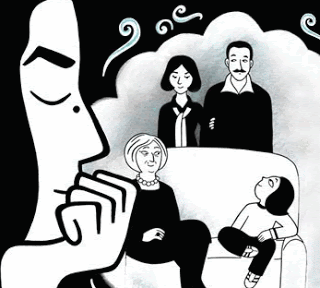Week 9: A Wide World of Comics
This week I read the graphic autobiography, Persepolis by Marjane Satrapi. The story depicts Satrapi's childhood and growing up in Iran during and after the Islamic Revolution. The story helps remind readers of the “precarity of survival” in political and social situations.
 The black and white format Satrapi uses to create the story is very powerful. There is a lot of dimension to the story as the text is very light and airy while the illustrations are very heavy and bold. This is similar to the graphic novel Maus, as Spiegelman uses a similar technique. In both instances, the story is very serious and has a dark tone, but the authors try to find a way to add a bit of light-heartedness while still not taking away from the main subject of the novels. Also, both Satrapi and Spiegelman use very bold and expressive black lines with no color added. This really emphasizes the story more but also creates a sense of hopelessness from the characters just from the use of line thicknesses and simplicity of the drawings.
The black and white format Satrapi uses to create the story is very powerful. There is a lot of dimension to the story as the text is very light and airy while the illustrations are very heavy and bold. This is similar to the graphic novel Maus, as Spiegelman uses a similar technique. In both instances, the story is very serious and has a dark tone, but the authors try to find a way to add a bit of light-heartedness while still not taking away from the main subject of the novels. Also, both Satrapi and Spiegelman use very bold and expressive black lines with no color added. This really emphasizes the story more but also creates a sense of hopelessness from the characters just from the use of line thicknesses and simplicity of the drawings.
Satrapi uses visual literacy throughout her comics to help enhance the main message of her story. Even though she has text throughout the comic, you can just look at the illustration and understand what is going on. It is as though you are able to "read" the illustrations. Satrapi utilizes a combination of the text and illustrations to represent Iranian and European culture through both images and language. Overall, I enjoyed reading this graphic novel and would recommend people to read it.
 The black and white format Satrapi uses to create the story is very powerful. There is a lot of dimension to the story as the text is very light and airy while the illustrations are very heavy and bold. This is similar to the graphic novel Maus, as Spiegelman uses a similar technique. In both instances, the story is very serious and has a dark tone, but the authors try to find a way to add a bit of light-heartedness while still not taking away from the main subject of the novels. Also, both Satrapi and Spiegelman use very bold and expressive black lines with no color added. This really emphasizes the story more but also creates a sense of hopelessness from the characters just from the use of line thicknesses and simplicity of the drawings.
The black and white format Satrapi uses to create the story is very powerful. There is a lot of dimension to the story as the text is very light and airy while the illustrations are very heavy and bold. This is similar to the graphic novel Maus, as Spiegelman uses a similar technique. In both instances, the story is very serious and has a dark tone, but the authors try to find a way to add a bit of light-heartedness while still not taking away from the main subject of the novels. Also, both Satrapi and Spiegelman use very bold and expressive black lines with no color added. This really emphasizes the story more but also creates a sense of hopelessness from the characters just from the use of line thicknesses and simplicity of the drawings. Satrapi uses visual literacy throughout her comics to help enhance the main message of her story. Even though she has text throughout the comic, you can just look at the illustration and understand what is going on. It is as though you are able to "read" the illustrations. Satrapi utilizes a combination of the text and illustrations to represent Iranian and European culture through both images and language. Overall, I enjoyed reading this graphic novel and would recommend people to read it.
Comments
Post a Comment